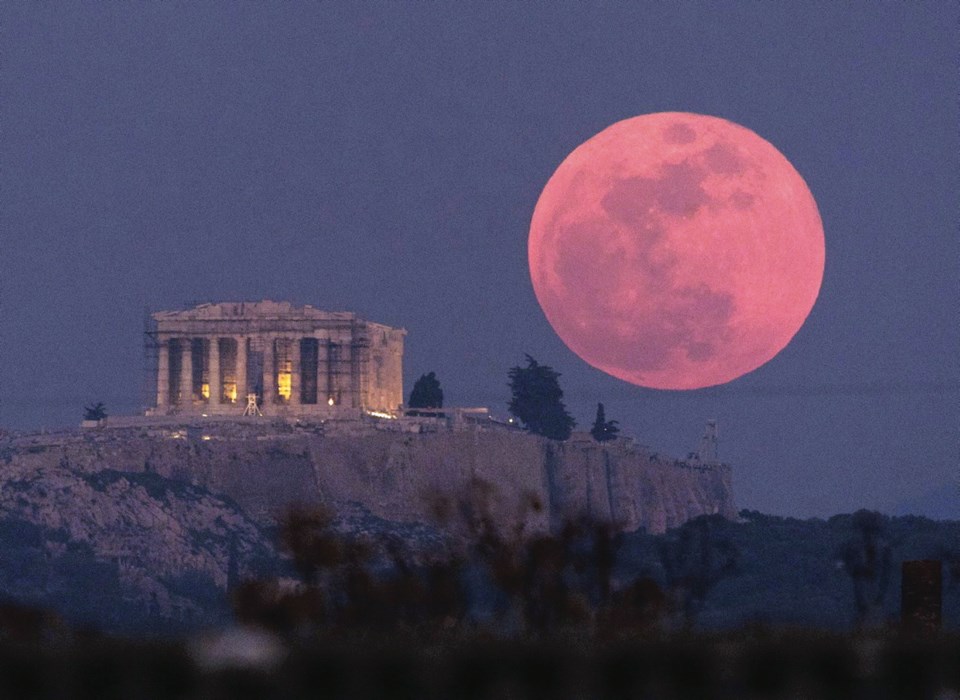Planning celebrations of celestial events for January evenings in this part of the world is always risky. Will the skies be clear for the extraterrestrial spectacle? Will they be clear at the right time and in the right part of the sky?
If you step outside and skies are clear tonight between 7:30 and 11, looking moonward, you will see something unusual. The moon will not only appear larger than normal, but its stately waltz across the sky will be enlivened with creeping shadows and lurid colours as Earth passes between it and the sun. Tonight, the majestic Queen of the Night will promenade a dance of the seven veils.
Tonight, a full supermoon total lunar eclipse will unfold.
Supermoons happen when the full moon occurs at the moon’s closest approach to the Earth. Because the orbit of our only natural satellite is not a perfect circle, once every month on its slightly egg-shaped path around our planet, the moon approaches Earth about 50,000 kilometres closer. When that close encounter happens in the full-moon phase, the moon looms bigger and more dramatically than usual.
Of course, no matter how big or small it may appear to us, the moon remains the same size.
Lunar eclipses happen when the sun, Earth and moon line up exactly. As the Earth begins to cast its shadow across the moon, the eclipsed part of the moon starts to glow a rusty hue. During totality, when the Earth completely enshadows the moon, some sunlight that is scattered and refracted around Earth by our atmosphere will reach the moon, dimly lighting it with a faint, reddish glow.
Totality will last about 62 minutes tonight. If the sky clears for the event, we’ll be able to see the entire eclipse unfold.
Even a century ago, our grandparents and great-grandparents who lived in rural areas planned winter evening events around the moon. No lights lined country roads, and kerosene lanterns hanging from sleighs and buggies shone dimly, so scheduling parties to coincide with the full-moon nights meant guests had light to help guide them home.
If the soirées occurred during a supermoon, our grandparents would think they were enjoying a 30 per cent brighter moon to travel home under than the usual full moon.
Lunar eclipses were sufficiently unusual that reference to the Farmer’s Almanac would have been needed and might have been another excuse to get together with neighbours to while away a long winter evening.
Although an overcast sky no longer keeps us from finding our way home at night, some animals are less lucky. Barau’s petrels, for example, synchronize their migration with the full moon when travelling to mating sites on Ile de La Réunion, in the Indian Ocean.
Throughout the Arctic Ocean, tiny marine animals called zooplankton use moonlight to guide their migrations between shallower and deeper water, sinking lower in the water column every 29.5 days when the full moon rises and light penetrates the deepest. The timing of the migration of the red crab across Australia’s Christmas Island is linked to the phases of the moon, enabling female crabs to time the release of their eggs into the sea precisely at the turn of the high tide during the last quarter of the moon.
Research indicates that the moon’s phases can profoundly influence our own reproductive cycles and sleep, as well as coincide with the number of emergency room visits we make due to heart attacks, diarrhea, traffic accidents and suicides.
Animal studies have revealed that the moon’s cycle affects hormones in insects, fish, birds, lab rats and sheep. Grunion fish, for example, spawn only a few days after a full or new moon, although scientists think this behaviour is tied to the tidal cycle, which is dictated by the gravitational pull of the moon. New research suggests oysters might also use the phases of the moon to synchronize behaviour across their bivalve colonies.
Although it’s not clear exactly how the moon influences us and other animals, some researchers suggest light reflected off the moon and the moon’s gravitational pull might trigger production of melatonin and steroids that cause our brains and bodies to respond.
It might sound crazy — even lunatic — but it’s no more improbable than a supermoon lunar eclipse.



